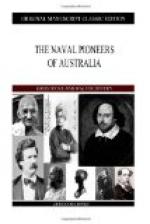LIST OF ILLUSTRATIONS
Martin Frobisher
FROBISHER’S map
A Dutch ship of war
sovereign of the seas
A sixth rate, 1684
Dampier
cook
governor Phillip
view of Botany bay
Sydney Cove
captain John Hunter
attack on the Waaksamheyd
governor king
La Perouse
sir Joseph banks
George Bass
Matthew Flinders
view of wreck reef
government house, Sydney, in 1802
view of Sydney
governor bligh
“Whenever I want a thing well done in a distant part of the world; when I want a man with a good head, a good heart, lots of pluck, and plenty of common sense, I always send for a Captain of the Navy.”—Lord Palmerston.
THE NAVAL PIONEERS
OF
AUSTRALIA
CHAPTER I.
Introductory—the earliest Australian voyagers: The Portuguese, Spanish, and Dutch.
Learned geographers have gone back to very remote times, even to the Middle Ages, and, by the aid of old maps, have set up ingenious theories showing that the Australian continent was then known to explorers. Some evidence has been adduced of a French voyage in which the continent was discovered in the youth of the sixteenth century, and, of course, it has been asserted that the Chinese were acquainted with the land long before Europeans ventured to go so far afloat. There is strong evidence that the west coast of Australia was touched by the Spaniards and the Portuguese during the first half of the sixteenth century, and proof of its discovery early in the seventeenth century. At the time of these very early South Sea voyages the search, it should always be remembered, was for a great Antarctic continent. The discovery of islands in the Pacific was, to the explorers, a matter of minor importance; New Guinea, although visited by the Portuguese in 1526, up to the time of Captain Cook was supposed by Englishmen to be a part of the mainland, and the eastern coast of Australia, though touched upon earlier and roughly outlined upon maps, remained unknown to them until Cook explored it.
[Illustration: Martin Frobisher. From the portrait in Holland’s “Herolowologia Anglica” [London, 1620]. To face p. 2.]




